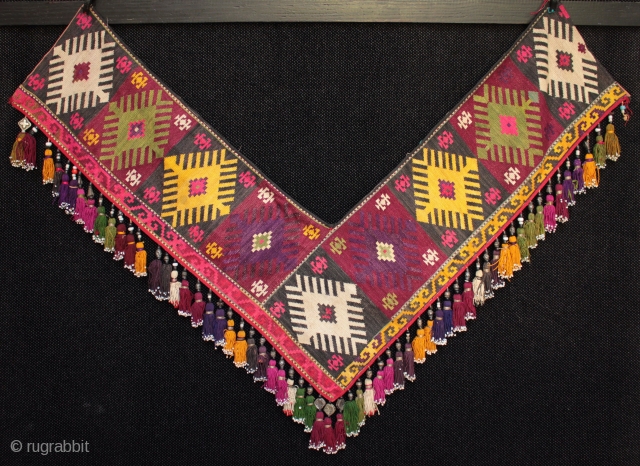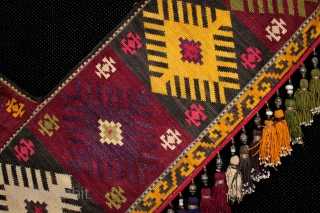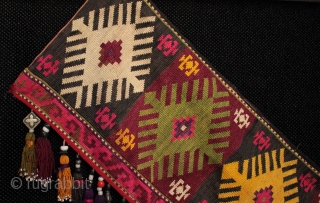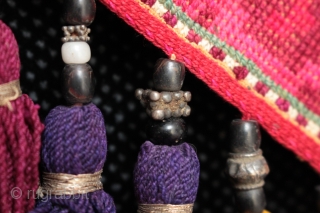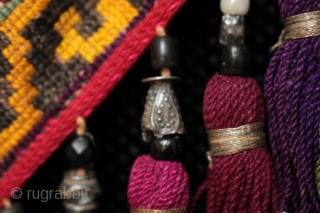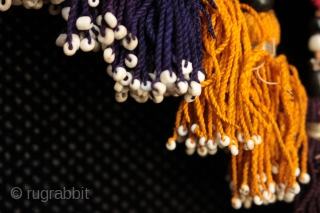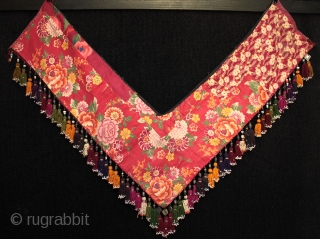Embroidered in silk using needlepoint technique with silk tassels and antique beads. In some cases the beads are older than the textile and are a particularly attractive feature of this segusha. They are made of glass, solid silver (the small square beads) and silver alloy (boteh pattern and diamond beads at bottom). The silk tassels are bound with silver metallic thread and the strands of each tassel end with a small white glass bead. The back is lined with old Uzbek trade cloth.
The segusha is often described as a bedding 'cover'. However, it appears it was actually the nomads filing system for bedding piles. It was originally part of a larger cloth placed between different family members' quilts with the triangular section hanging down at the front. i have also seen it reported that it was originally stitched to the end a particular quilt, further supporting the idea that an individual segusha related to an individual person's bedding. Whether or not they originally had any kind of protective, magical purpose, like the smaller triangular textile amulets, in addition to an organisational and latterly just a decorative function is open to further research. It would certainly make sense to me, as we are at our most vulnerable when asleep, so it seems to me that giving bedding magical protection would be quite sensible for the nomad. Circa early 1900s. In excellent condition. Size 98cm across, each bands 20cm wide and 75cm long including 8cm tassels.
For more on Lakai textiles see: http://sanat.orexca.com/2012/2012-3/the-forgotten-tribe-of-lakai-the-mag... and Hali, Issue 75 June/July 1994.
For more photos see: http://www.kilim.ie/TRIBAL_RUGS_and_KILIMS/Pages/NEW_ARRIVALS.html
Please contact me for more information.
- Home
- Antique Rugs by Region
- Category
- Profiles
- Post Items Free
- Albums
- Benaki Museum of Islamic Art
- Budapest: Ottoman Carpets
- Gulbenkian Museum
- Islamic Carpets. Brooklyn
- Islamic Textiles. Brooklyn
- Konya Museum: Rugs
- MKG, Hamburg
- MMA: Caucasian Carpets
- MMA: Mamluk Carpets
- MMA: Mughal Indian Carpets
- MMA: Ottoman Carpets
- MMA: Safavid Persian Carpets
- MMA: Turkmen Rugs
- McCoy Jones Kilims
- Ottoman textiles. Met
- Philadelphia Museum
- Rugs and Carpets: Berlin
- Seljuqs at the Met
- TIEM, Istanbul: Carpets
- V&A: Classical Carpets
- Vakiflar Carpets: Istanbul
- Baluch Rugs: Indianapolis
- Gallery Exhibitions
- Jaf an Exhibition
- Alberto Levi Gallery
- Andean Textile
- Christie's London: 2016
- Francesca Galloway
- HALI at 40
- ICOC Washington, DC 2018
- Jajims of the Shahsavan
- London Islamic Week April, 2018
- Mongolian Felts
- Navajo Rugs: JB Moore
- Persian Piled Weavings
- SF Tribal & Textile Art Show 2020
- SF Tribal 2019
- Sotheby's: C. Alexander
- Turkish Prayer Rugs
- Turkmen Main Carpets ICOC 2007










